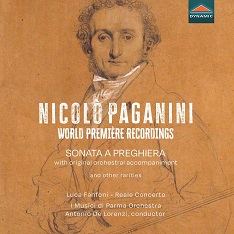Eine Auswahl an kaum bekannten Werken, gepaart mit auch bekannten von Nicolo Paganini, darunter vier Ersteinspielungen bei acht Werken, hat Luca Fanfoni gefunden, die er solistisch oder zusammen mit anderen vorträgt. Dabei reicht die Spannweite von einer Sonate mit Orchester über ein Streichquartett sowie eine Sonate für drei Violinen und einer für Violine und Gitarre bis hin zu Solostücken. Davon dauern manche nur Sekunden.
Die erste und wichtigste dieser Weltersteinspielungen ist die der Sonata a preghiera, die mit der Original-Orchesterbegleitung erstmals zu erleben ist. Aus den überlieferten Stimmen wird deutlich, dass die Komposition ohne die kurzen Einleitungsteile und als freie Ausarbeitung, die größtenteils auf einer Rekonstruktion der Bearbeitung von Rossinis Melodie ‘Dal tuo stellato soglio’ und des darauf folgenden ‘Tema variato’ beruhen, geschaffen wurde.
Bei La Sonata a Violino Scortado dedicata all’Intreccio e Balli dell’Orsi handelt es sich mit ziemlicher Sicherheit um ein frühes virtuoses Werk für eine Solovioline, die von zwei weiteren Instrumenten begleitet wird. Sie ist damit einzigartig. Da nur wenige Seiten des Autographs zugänglich sind, ist eine abschließende Bewertung unmöglich.
Die Ausgangslage ist auch bei der Sonate Maria Luisa für Violine mit begleitender skordierter Gitarre unklar. Fanfoni spielt auch zwei kurze Solowerke. Die vier Quattro Notturni a quartetto werden hier in einer Bearbeitung für Streichquartett, vorgestellt.
Paisiellos Oper La bella molinara wurde von Paganini in einem seiner berühmtesten Werke verwendet, dem Capriccio a violino solo ‘In cor più non mi sento’. Die sieben Variationen zeigen die spektakulärsten Effekte von Paganinis Technik.
Engagiert nimmt sich Fanfoni dieser Werke an. Er vermeidet jede rein oberflächliche virtuose Behandlung, in dem er auch in der Wahl der Tempi nicht übertreibt. Damit mag zwar ein an glänzendem Auftritt Interessierter manches vermissen. Aber die Musik hat mehr Chancen, sich zu entfalten und die Nuancen preiszugeben. Luca Fanfoni zieht jedenfalls die Register, um die Musik ansprechend zu präsentieren.
Auch die anderen Interpreten steuern gelungene Leistungen bei, so dass alle zusammen ein abwechslungsreiches Programm geschaffen haben, das Neuigkeiten bietet.
Luca Fanfoni has found a selection of little-known works paired with well-known works by Nicolo Paganini, including four first recordings of eight works, which he performs as a soloist or together with others. These range from a sonata with orchestra to a string quartet, a sonata for three violins and one for violin and guitar, as well as the solo pieces mentioned above. Some of them last only seconds.
The first and most important of these world premiere recordings is that of the Sonata a preghiera, which can be experienced for the first time with the original orchestral accompaniment. It is clear from the surviving parts that the composition was created without the short introductory sections and as a free arrangement, largely based on a reconstruction of the arrangement of Rossini’s melody ‘Dal tuo stellato soglio’ and the following ‘Tema variato’.
La Sonata a Violino Scortado dedicata all’Intreccio e Balli dell’Orsi is almost certainly an early virtuoso work for a solo violin accompanied by two other instruments. It is therefore unique. As only a few pages of the autograph are accessible, a conclusive evaluation is impossible.
The starting point for the Maria Luisa Sonata for violin with accompanying scordatura guitar is also unclear. Fanfoni also plays two short solo works. The four Quattro Notturni a quartetto are presented here in an arrangement for string quartet.
Paisiello’s opera La bella molinara was used by Paganini in one of his most famous works, the Capriccio a violino solo « In cor più non mi sento ». The seven variations show the most spectacular effects of Paganini’s technique.
Fanfoni tackles these works with dedication. He avoids any purely superficial virtuoso treatment by not exaggerating in his choice of tempi. This may mean that those interested in a brilliant performance may miss something. But the music has more chance to unfold and reveal its nuances. In any case, Luca Fanfoni pulls out all the stops to present the music in an appealing way.
The other performers also contribute successful performances, so that together they have created a varied program that offers something new.




















